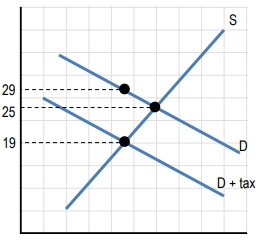Taxes play a crucial role in funding public services such as education, police, and fire departments. The government collects taxes to ensure these essential services are available to the public. In this context, taxes can be imposed on either the buyer or the seller, and we will focus on per unit taxes, which are charged for each unit exchanged. For instance, if a \$1 tax is levied, a buyer purchasing one unit pays the unit price plus an additional \$1 in tax.
When a tax is imposed, it affects the supply and demand curves in the market. Specifically, the curve will shift to the left by the amount of the tax, indicating a decrease in the quantity exchanged at equilibrium. This shift results in a new equilibrium price and quantity, which reflects the tax burden shared between buyers and sellers. The price paid by the buyer (denoted as \( P_B \)) will differ from the price received by the seller (denoted as \( P_S \)). For example, if the buyer pays a tax, they will pay the price of the good plus the tax, while the seller will receive the price of the good minus the tax.
To illustrate, consider a scenario where a \$2 tax is imposed on buyers. Initially, the market equilibrium price is \$6, and the quantity exchanged is at \( Q^* \). After the tax is applied, the demand curve shifts leftward, resulting in a new equilibrium price of \$5.10 for sellers and \$7.10 for buyers. This demonstrates that the tax burden is not solely borne by the buyer; instead, it is shared, with the seller receiving less than the original price.
Similarly, if the tax is imposed on sellers, the supply curve shifts leftward by the same amount, leading to the same new equilibrium prices and quantities. This indicates that regardless of whether the tax is levied on buyers or sellers, the market ultimately reaches the same outcome. The only difference lies in which curve shifts, but the final prices and quantities remain consistent.
Understanding tax incidence is essential, as it reveals how the burden of the tax is distributed between consumers and producers. In our example, the total tax was \$2, with consumers bearing \$1.10 and producers \$0.90. This can also be expressed in percentages, showing that consumers pay 55% of the tax while producers pay 45%. This distribution is influenced by the elasticity of demand and supply, which determines how the burden is shared.
In summary, taxes are a vital mechanism for funding public services, and their imposition affects market equilibrium by shifting supply or demand curves. The resulting tax incidence illustrates how the burden is shared between buyers and sellers, regardless of who is officially taxed.


